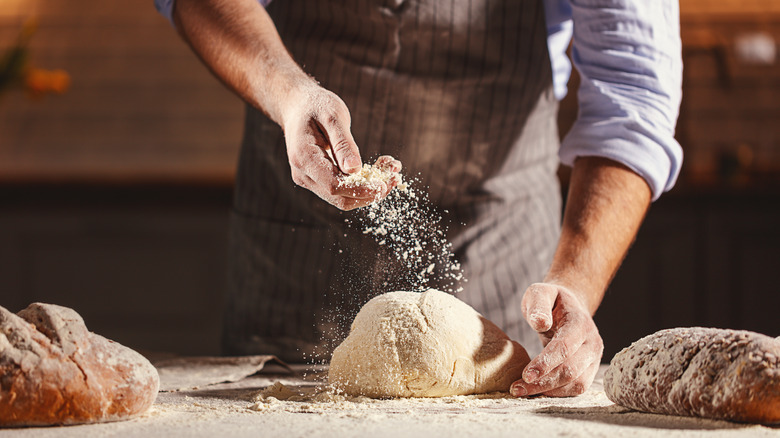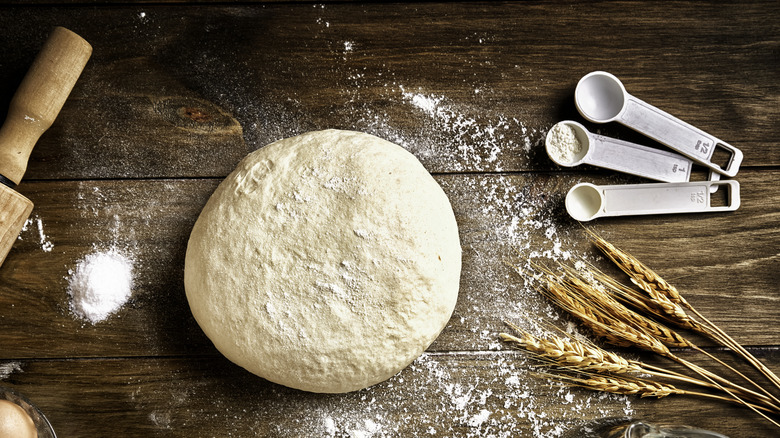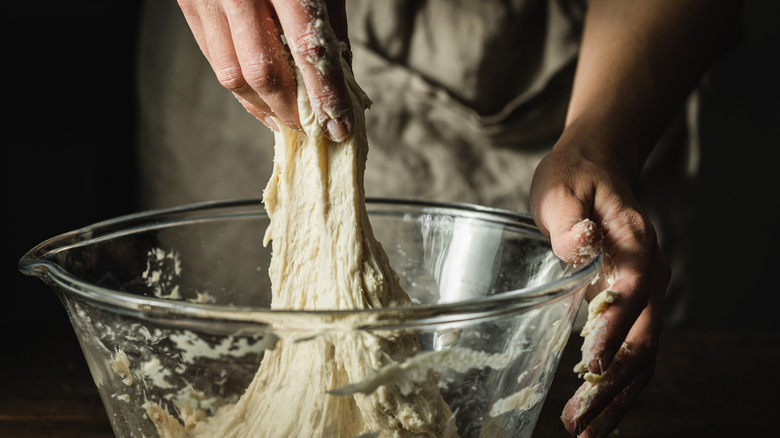The Slap And Fold Technique For Unbeatable Sourdough Bread
For any serious sourdough baker, kneading is a crucial skill. If you want a soft, perfectly risen bread, then knowing your bread is kneaded correctly is essential. When you mix bread's ingredients together, the gliadin and glutenin proteins in flour and water combine to form gluten strands. As you work all of the sourdough's ingredients together, you are developing those strands and bonding molecules for the dough's elasticity, as well as forming long chains of amino acids that hold in the gases of the leavening agent (in this case, the sourdough starter) that lead to the bread's bubbles and rise.
Kneading is an important scientific process to ensure that your sourdough has the right texture and bake, but there's more than one way to approach it. For an efficient, delightfully aggressive kneading technique, you're going to want to try the slap and fold. This kneading technique was made popular by Richard Bertinet, a well-regarded Breton baker and founder of The Bertinet Kitchen Cookery School in Bath, U.K. The slap and fold — also called the French method or French fold – works well for medium- to high-hydration sourdoughs so you can combat the stickiness and end up with a smooth, strong dough and a perfect homemade sourdough bake.
Put it all on the table (or the counter)
First, how it's done: As you might have guessed, this method involves enjoyable, stress-relieving slapping and folding of dough. Initially, you'll take the dough carefully in your hands, then quickly and forcefully slap it down on your work surface. After the slap, you'll fold the dough over, pick it up from the same side you did initially (letting it stretch as you lift), then slap it down again, rinse, and repeat. At first, there will be a lot of dough flying every which way — especially if you tend to be particularly rough or eager with the slapping step — and some sticky dough will cling to the table and your hands. However, as the gluten develops and the dough stretches with each lift, it will become stronger and more uniform. It can be helpful to move quickly to avoid letting the dough puddle and stick to the work surface.
It's a useful way to deal with the higher hydration doughs, as sourdoughs can be, which might be more difficult to work with and too sticky for gentler kneading methods. The method develops gluten very efficiently so that you can get your sourdough into shape quickly and not feel like you're losing a fight against your bread. Of course, it isn't for the faint-hearted. If the slapping gets too lively, then you may be scraping bits of dough off the backsplash grout — but it's worth the mess for taming difficult doughs.
The kneading techniques that you absolutely need
If such a high-energy technique doesn't appeal to your baking sensibilities, there are more docile dough-kneading methods to rely on — or you could try a recipe for no-knead sourdough bread. If you're prepared to get your hands dirty, though, you might want to start by mastering the basic fold, also called the boulangerie technique, which just requires folding the dough, pushing in with the heel of your hands, and repeating. For a little less mess, you can also knead the dough still in the bowl by grabbing it with your fingers, folding it over on itself, and turning the bowl before you repeat the steps.
Kneading wetter doughs might be a challenge using these methods, so if you're not prepared to slap, then it might be useful to get a dough scraper to move it around and help with kneading. It's tempting to coat these wetter doughs in flour when you knead them to make them easier to deal with, but that can affect the bake — so tools are helpful to keep the dough off your hands.


